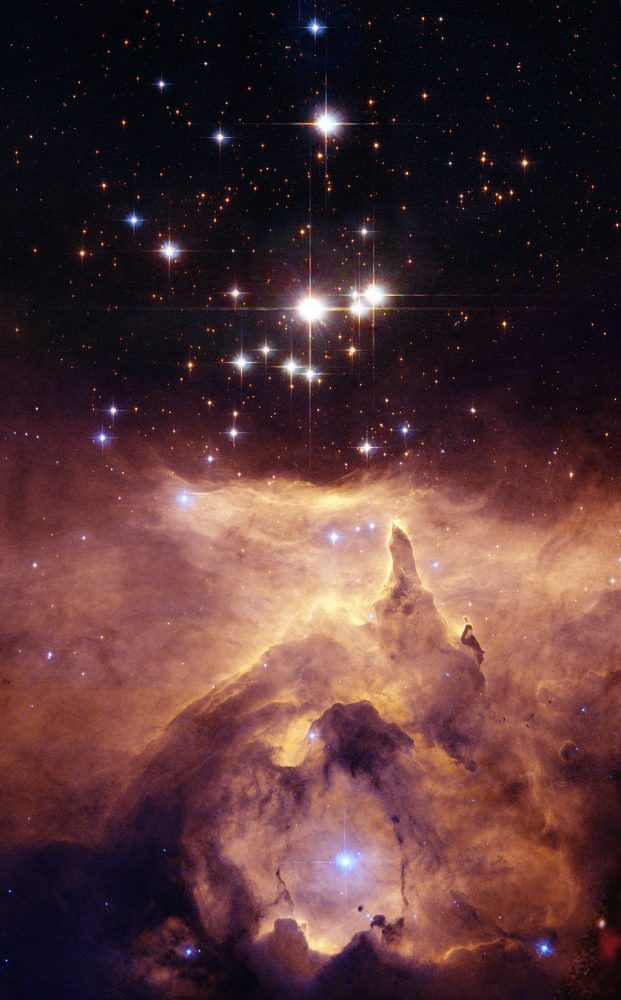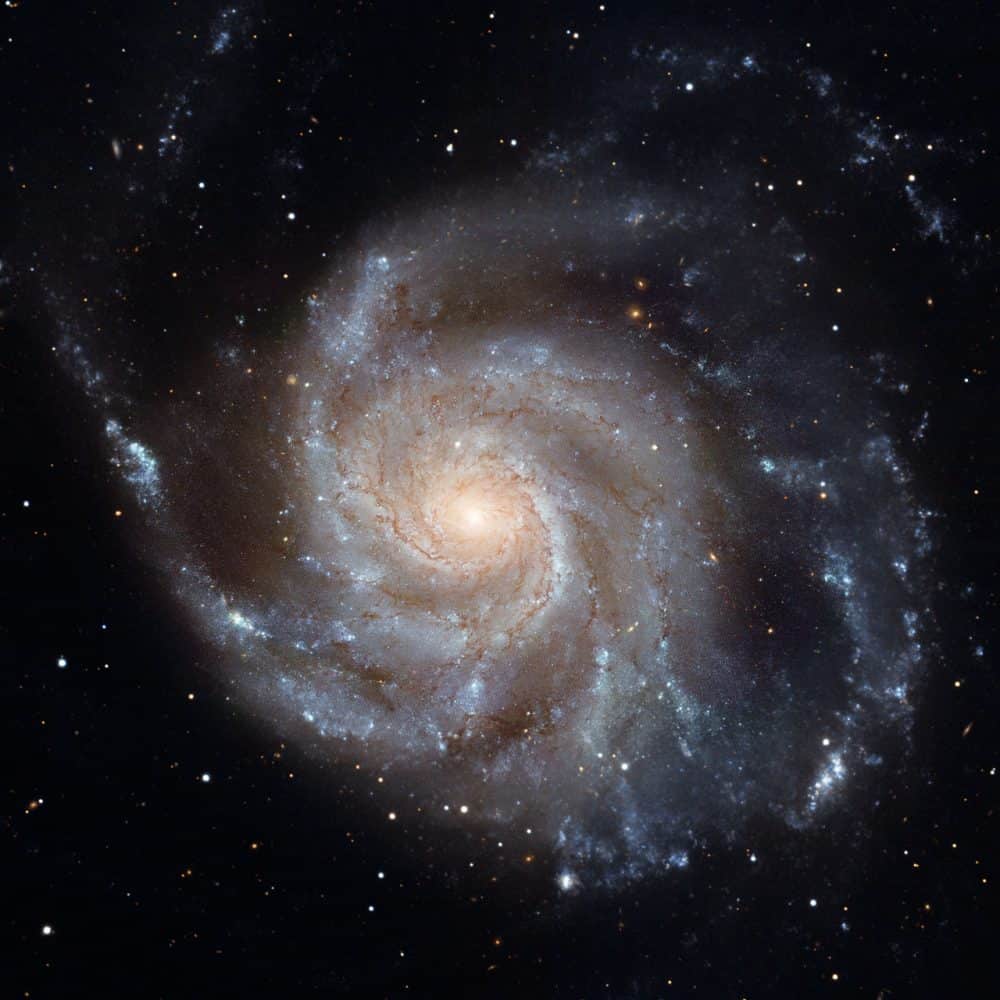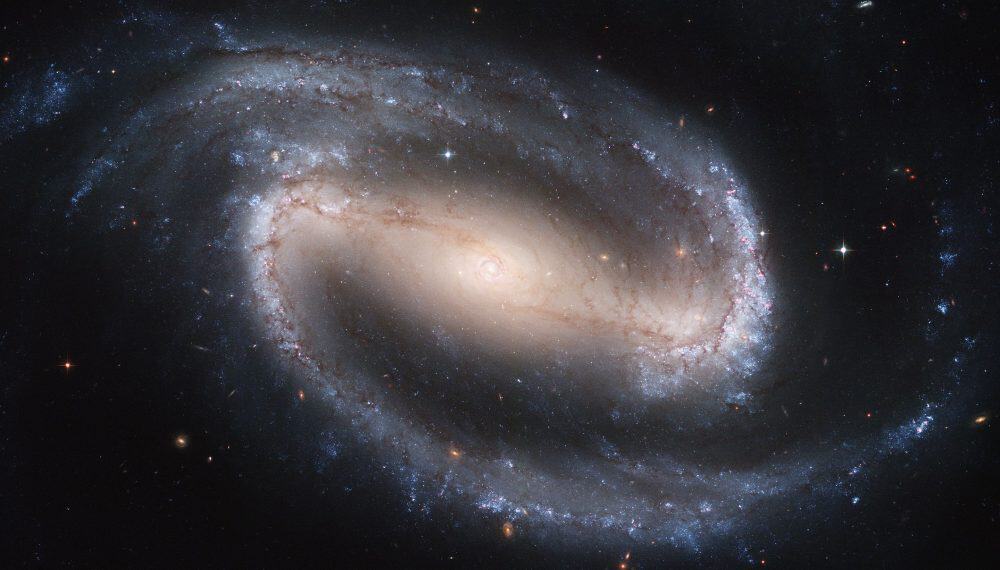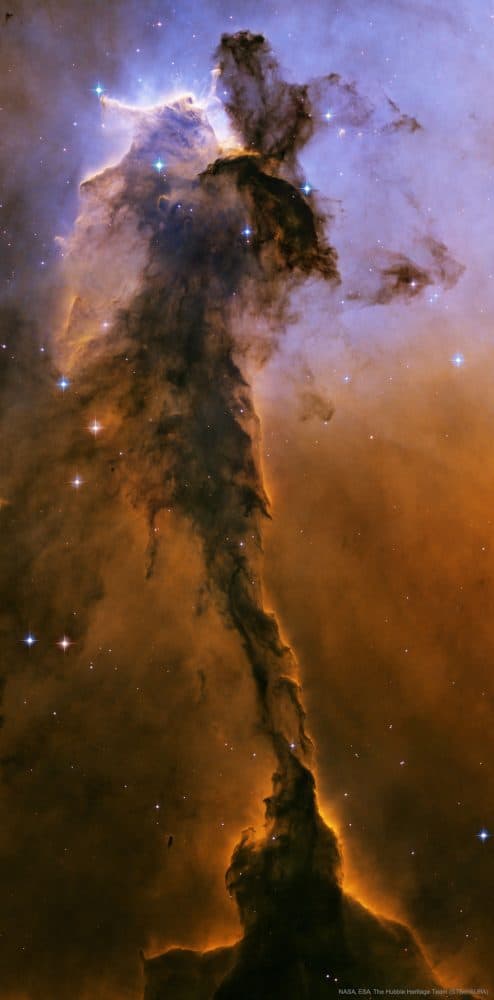Blog
The star cluster Pismis 24 lies in the core of the large emission nebula NGC 6357 that extends one degree on the sky in the direction of the Scorpius constellation. Part of the nebula is ionised by the youngest (bluest) heavy stars in Pismis 24. The intense ultraviolet radiation from the blazing stars heats the gas surrounding the cluster and creates a bubble in NGC 6357. The presence of these surrounding gas clouds makes probing into the region even harder.
NGC 6357 is a diffuse nebula near NGC 6334 in the constellation Scorpius. The nebula contains many proto-stars shielded by dark disks of gas, and young stars wrapped in expanding “cocoons” or expanding gases surrounding these small stars. It is also known as the Lobster Nebula.
This nebula was also given the name War and Peace Nebula by the Midcourse Space Experiment scientists because of its appearance. They said that in infrared images the bright, western part resembles a dove, while the eastern part looks like a skull.
It is located about 5500 light years away from Earth
more...Egberto Amin Gismonti (born December 5, 1947 in Carmo, state of Rio de Janeiro) is a Brazilian composer, guitarist and pianist.
Gismonti was born in the small city of Carmo, state of Rio de Janeiro, Brazil, into a musical family. His mother was from Sicily and his father was from Beirut, Lebanon. At the age of six, he started studying the piano at the Brazilian Conservatory of Music. After studying the classical repertoire in Brazil for fifteen years, he went to Paris to delve into modern music. He studied with Nadia Boulanger (1887–1979), after acceptance as a student by the composer Jean Barraqué, a student of Anton Webern and Schoenberg. Boulanger encouraged Gismonti to write the collective Brazilian experience into his music.
more...
Art Davis (December 5, 1934 – July 29, 2007) was a double-bassist, known for his work with Thelonious Monk, John Coltrane, Dizzy Gillespie, McCoy Tyner and Max Roach.
Davis was born in Harrisburg, Pennsylvania, where he began studying the piano at the age of five, switched to tuba, and finally to bass while attending high school. He studied at Juilliard and Manhattan School of Music but graduated from Hunter College.
As a New York session musician, he recorded with many pop acts and also in symphony orchestras such as the Los Angeles Philharmonic. Art Davis was a professor at Orange Coast College.
Davis is also known for starting a legal case that led to blind auditions for orchestras.
Davis earned a Ph.D. in clinical psychology from New York University in 1982. He moved in 1986 to southern California, where he balanced his teaching and practicing of psychology with jazz performances.
more...Richard Wayne Penniman (born December 5, 1932), known as Little Richard, is an American recording artist, singer-songwriter and actor.
A pop music and culture icon, Little Richard’s most-celebrated work dates from the mid-1950s when his dynamic music and charismatic showmanship presaged the rise of rock and roll. His music influenced many other popular music genres, including soul, funk and hip hop and shaped generations of rhythm and blues artists.
Little Richard has been honored by many institutions. He was inducted into the Rock and Roll Hall of Fame as part of its first group of inductees in 1986. He was also inducted into the Songwriters Hall of Fame. He is the recipient of a Lifetime Achievement Award from the Recording Academy and a Lifetime Achievement Award from the Rhythm and Blues Foundation. Little Richard’s “Tutti Frutti” (1955) was included in the National Recording Registry of the Library of Congress in 2010, which stated that his “unique vocalizing over the irresistible beat announced a new era in music.” In 2015, the National Museum of African American Music[1] honored Little Richard with a Rhapsody & Rhythm Award for his role in the formation of popular music genres and in helping shatter racial divisions in the music industry.
Little Richard was born Richard Wayne Penniman on December 5, 1932, in Macon, Georgia. He was the third of twelve children of Leva Mae (née Stewart) and Charles “Bud” Penniman. His father was a church deacon who sold bootlegged moonshine on the side and owned a nightclub, the Tip In Inn. His mother was a member of Macon’s New Hope Baptist Church.
more...The Pinwheel Galaxy (also known as Messier 101, M101 or NGC 5457) is a face-on spiral galaxydistanced 21 million light-years (six megaparsecs) away from Earth in the constellation Ursa Major. First discovered by Pierre Méchain on March 27, 1781, it was communicated to Charles Messier who verified its position for inclusion in the Messier Catalogue as one of its final entries.
On February 28, 2006, NASA and the European Space Agency released a very detailed image of the Pinwheel Galaxy, which was the largest and most detailed image of a galaxy by Hubble Space Telescope at the time. The image was composed of 51 individual exposures, plus some extra ground-based photos.
On August 24, 2011, a Type Ia supernova, SN 2011fe, was discovered in M101.
more...Cassandra Wilson (born December 4, 1955) is an American jazz musician, vocalist, songwriter, and producer from Jackson, Mississippi. Described by critic Gary Giddins as “a singer blessed with an unmistakable timbre and attack [who has] expanded the playing field” by incorporating blues, country, and folk music into her work, Wilson has won two Grammy Awards.
Cassandra Wilson is the third and youngest child of Herman Fowlkes, Jr., a guitarist, bassist, and music teacher; and Mary McDaniel, an elementary school teacher who earned her PhD in education. Her ancestry includes Fon, Yoruba, Irish and Welsh. Between her mother’s love for Motown and her father’s dedication to jazz, Wilson’s parents sparked her early interest in music.
more...Denis Charles (December 4, 1933 – March 26, 1998) was a jazz drummer.
Charles was born in St. Croix, Virgin Islands, and first played bongos at age seven with local ensembles in the Virgin Islands. In 1945 he moved to New York, and gigged frequently around town. In 1954 he began working with Cecil Taylor, and the pair collaborated through 1958. Following this he played with Steve Lacy, Gil Evans, and Jimmy Giuffre. He befriended Ed Blackwell, and the two influenced each other.
He recorded with Sonny Rollins on a calypso-tinged set, and then returned to time with Lacy, with whom he played until 1964. He worked with Archie Shepp and Don Cherry in 1967 and then disappeared from the record until 1971. In the 1970s and 1980s he played regularly on the New York jazz scene with Frank Lowe, David Murray, Charles Tyler, Billy Bang, and others, and also played funk, rock, and traditional Caribbean music. He released three discs as a leader between 1989-1992, and died in New York City in 1998.
Denis Charles died four days after a five-week European tour with the Borgmann/Morris/Charles (BMC) Trio, with Wilber Morris and Thomas Borgmann. His last concert with this trio took place at the Berlin Willy-Brandt-Haus. With the BMC Trio he recorded in his last two years about four CDs. The fifth CD was released after he died: The Last Concert – Dankeschön, Silkheart Records, 1999.
more...James Stanley Hall (December 4, 1930 – December 10, 2013) was an American jazz guitarist, composer and arranger. Premier Guitarmagazine stated that “It could be argued that the jazz guitar tree is rooted in four names: Django [Reinhardt], Charlie [Christian], Wes[Montgomery], and Jim [Hall]”.
Born in Buffalo, New York, before moving to Cleveland, Ohio, Hall was from a musical family, his mother played the piano, his grandfather violin, and his uncle guitar. He began playing the guitar at age ten when his mother gave him an instrument as a Christmas present. At 13 he heard Charlie Christian play on a Benny Goodman record, which he calls his “spiritual awakening”. As a teenager in Cleveland, he performed professionally, and also took up the double bass. Hall’s major influences since childhood were tenor saxophonists Coleman Hawkins, Lester Young, Paul Gonsalves, and Lucky Thompson. While he copied out solos by Charlie Christian, and later Barney Kessel, it was horn players from whom he took the lead.
more...https://www.youtube.com/watch?v=mmm1NAr7eBE
more...NGC 1300 is a barred spiral galaxy located about 61 million light-years away in the constellation Eridanus. The galaxy is about 110,000 light-years across (about the same size of the Milky Way). It is a member of the Eridanus Cluster, a cluster of 200 galaxies. It was discovered by John Herschel in 1835.
In the core of the larger spiral structure of NGC 1300, the nucleus shows a “grand-design” spiral structure that is about 3,300 light-years long. Only galaxies with large-scale bars appear to have these grand-design inner disks — a spiral within a spiral. Models suggest that the gas in a bar can be funneled inwards, and then spiral into the center through the grand-design disk, where it can potentially fuel a central supermassive black hole (SMBH). NGC 1300 is not known to have an active nucleus, indicating that its central black hole is not accreting matter. The SMBH has a mass of 7.3+6.9
−3.5×107 M☉
December 3nd 1954
Mark Boling is a jazz guitarist, teacher, composer, and author.An Associate Professor of Music at the University of Tennessee, Boling serves as Coordinator of the Jazz Studies Program. As a veteran sideman with pianist Donald Brown, Boling played in Tennessee-based bands and recorded with Brown on three records for the French label Space Time Records. Boling performs frequently leading his own trio, featuring drummer Keith Brown and bassist Jon Hamar. Boling has released three recordings as a leader (Trio Life, 2012; Tune Me, 2004; Evidence, 2000). In addition, he has performed with the Knoxville Jazz Orchestra, the Knoxville Symphony Orchestra, and a number of acclaimed jazz musicians, including Gregory Tardy, Zim Ngqawana, Donald Brown and Jerry Coker. He is the author of Creative Comping Concepts for Jazz Guitar (Mel Bay), The Jazz Theory Workbook(Advance Music), Elements of the Jazz Language software (CPP/Belwin), and Curriculum for Aural Training software. Boling has been a senior artist-in-residence at the Banff Center International Jazz Workshop, a visiting artist at the Brubeck Institute, and a teacher at Berklee College of Music’s summer guitar program. He received a Bachelor of Music degree from the Berklee College of Music in Boston (1981) and a Masters in Music Theory from the University of Tennessee (1984).
more...December 3nd 1953
The history of jazz is strewn with brilliant players who have inexplicably eluded widespread recognition, flying under the radar of labels, journalists, and fans. But guitarist David Haskell’s stealth status over the past two decades isn’t hard to explain. He’s spent most of that time on the move as a commercial pilot, fulfilling a dream that took root as a child, about the same time he became enamored with the guitar. Before Haskell took to the air as a profession, he was a widely respected improviser at the center of the San Francisco jazz scene, a versatile, blues-drenched player often heard as a sideman and bandleader at high profile venues like Keystone Korner.
Now that he’s hung up his wings, Haskell is once again making waves on the Bay Area scene, working with a superlative group. With his lean, fluid tone, clean attack, and simmering sense of swing, Haskell is back in fighting trim, ready to pick up his music career where he left off back in the mid-1980s.
Born into a jazz-loving San Francisco family, Haskell soaked up the sounds of Duke Ellington and Count Basie from the record collection of his father, a doctor. When his father’s medical career took the family to Ukiah, they ended up moving near a small airfield, which sparked Haskell’s lifelong love of flying. He credits the Beatles’ invasion of America with turning him onto the guitar, and by the mid-1960s he was leading a garage band. While initially inspired by the straight ahead artistry of guitarists like Wes Montgomery, Howard Roberts, and Barney Kessel, Haskell fell in with a trio of blues loving brothers, Mark, Patrick, and Robben Ford, who turned him onto the Chicago sound.
“Robben Ford had a bluesy R&B band with horns, and when he took off for the summer to play with his brothers in San Francisco I ended up subbing for him,” Haskell recalls. “When he came back he played alto sax and I took over the guitar chair. Of course, he was still playing guitar with his brothers in Charles Ford Blues Band and he became a role model and mentor for me.”
Working with Robben, Haskell performed in churches, schools, and social halls around Ukiah, and when the Fords relocated to the Bay Area, he used to head down on weekends to hear them play. “I barely finished high school, because I needed to get out of Ukiah,” Haskell says. “I graduated in 1972, and the Fords engineered it so that I came down and joined a blues band.”
After a few years playing blues, Haskell fell in with a succession of exceptional pianists based in the Bay Area, including Yugoslav-raised Larry Vuckovich, Smith Dobson, Larry Dunlap, and New Zealand-born Mike Nock, who featured the guitarist on a gig with his seminal fusion combo the Fourth Way at the Great American Music Hall. While gaining invaluable bandstand experience, he started making a name for himself as one of the hottest young guitarists in the area. When Native American tenor saxophonist Jim Pepper, a jazz/rock fusion pioneer who co-led The Free Spirits, decamped from New York City in 1974, he quickly scooped up Haskell, bringing him to Alaska for a four-month gig the following year.
Back in the Bay Area, Haskell started playing with pianist Mark Soskin. When Pepper returned to town, the saxophonist launched a new incarnation of Pepper’s Powwow with Haskell, bassist Ratzo Harris, and pianist Russell Ferrante (who went on to found the Yellowjackets). Featuring a singular sound blending rock, post-bop jazz, and Native American influences, the group worked steadily for several years performing up and down the West Coast, with long sojourns in Portland and Alaska.
In 1977 Haskell decided to launch his own combo, the David Haskell Group. Honing a book of intricate, rock-tinged compositions, Haskell attracted several rising young stars, like pianist Susan Muscarella, who was also working with saxophonist Mel Martin’s popular band Listen. When she left, multi-instrumentalist Bruce Williamson, best known these days as a lyrical saxophonist, took over the piano chair. With regular gigs at Keystone Korner and a devoted local following, the DHG signed a contract with Theresa Records and made an album produced by Mark Isham, but it was never released.
When he wasn’t leading his own band, Haskell often worked with keyboardist Jeff Lorber and harmonica ace Mark Ford, his high school buddy from Ukiah. Playing with Ford’s band gave Haskell the opportunity to share stages with blues and R&B institutions like Muddy Waters, Albert King, and Tower of Power. Around the same time, a call from organ star Merl Saunders led to a gig backing soul singer Randy Crawford on the Crusaders’ 1980 national tour. Haskell continued to work with Saunders throughout that year.
more...Joseph William “Joe” Thomas, also known as Brother Cornbread (December 3, 1902 – February 18, 1981) was an American jazz clarinetist and singer, closely associated with the New Orleans jazz scene.
Thomas’s first professional gig was in New Orleans with trombone player Joe Harris in 1923. Soon after that, he worked with Jack Carey, Chris Kelly, and Kid Rena. He recorded with Charles Derbigny in 1941, but the recordings were not publicly released until the 1960s, by which time Thomas had become a figure in the Dixieland revival movement. He led his own ensemble at New Orleans’s H&J Tavern for much of the 1940s, then, in 1951, became a sideman for Papa Celestin. He worked with this ensemble for years, including after Papa French and Eddie Pierson had taken over as leader. Other associations in the 1950s and 1960s included work with Freddie Kohlman, Punch Miller, the Olympia Brass Band, and on Swedish television with Sweet Emma Barrettin 1968. In the 1970s he worked with the Legends of Jazz, replacing Joe Darensbourg.
more...A well-known musician in Niger, Mamane Barka takes with him a legacy of reviving the spirit of the biram, the five-string harp native to the Boudouma tribe of fishing nomads living by Lake Tchad in Niger.
more...The dust sculptures of the Eagle Nebula are evaporating. As powerful starlight whittles away these cool cosmic mountains, the statuesque pillars that remain might be imagined as mythical beasts. Featured here is one of several striking dust pillars of the Eagle Nebula that might be described as a gigantic alien fairy. This fairy, however, is ten light years tall and spews radiation much hotter than common fire. The greater Eagle Nebula, M16, is actually a giant evaporating shell of gas and dust inside of which is a growing cavity filled with a spectacular stellar nursery currently forming an open cluster of stars. This great pillar, which is about 7,000 light years away, will likely evaporate away in about 100,000 years. The featured image in scientifically re-assigned colors was released in 2005 as part of the fifteenth anniversary celebration of the launch of the Hubble Space Telescope.
more...More Posts
- World Music with Tamikrest
- Daily Roots with Armageddon Clash
- Music for Surviving the Pandemic
- Idir Memorial
- Richie Cole Memorial
- The Cosmos with CW Tauri: [B77] 71 (Bernes)
- Sonny Payne Day
- Ron Carter Day
- Don Friedman Day
- Maynard Ferguson Day
- Umm Kulthum Day
- World Music with Marla Leigh
- Daily Roots with Jah Bless
- Music for Surviving the Pandemic
- WEAR YOUR FACE MASK
- MAYDAY Parade, Ceremony & Festival CANCELLED 2020
- The Cosmos with M1
- James Brown Day
- Jimmy Cleveland Day
- Pete Seeger Day



